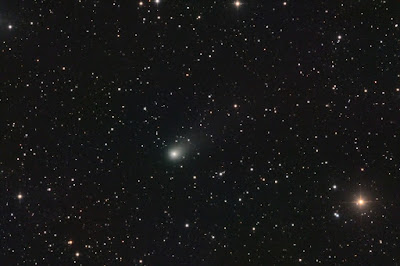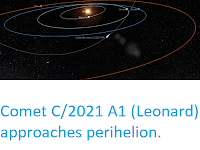Comet C/2019 L3 (ATLAS) made its closest approach to the
Earth on Friday 7 January 2022, reaching a distance of 2.58
AU from the Earth (258%
of the distance between the Earth and the Sun, or 386 096 000 km), and will reach perihelion (its closest approach to the Sun) on Sunday 9
January, when it will be 3.55 AU (531 684 000 km) from the Sun. At
this distance the comet will be not naked eye visible, having a
magnitude about 12.3, comparable to that of the moons of Mars, and
therefore not really visible to amateur astronomers without fairly good equipment. The comet is
currently in the
Constellation of Gemini.
Comet C/2019 L3 (ATLAS) imaged on 5 October 2021 from Mayhill, New Mexico. Pepe Chambó/Sky & Telescope.
C/2019 L3 (ATLAS) was discovered on 10 June 2019 by the Asteroid Terrestrial-impact Last Alert System (ATLAS) search program.
The name C/2019 L3 (ATLAS) implies that it is a comet
(C/), that it was the third comet (3) discovered in
the first half of June 2019 (period 2019 L) and that it was
discovered by the ATLAS program.
C/2019 L3 (ATLAS) is a Parabolic Comet, which is to say a comet that
has been disrupted from an orbit in the Oort Cloud, and to be passing
through the Inner Solar System on a parabolic orbit that will probably
not bring it back again. This parabolic trajectory tilted
at an angle of 48.4° to the plain of the Solar System, that will bring it
in to 3.55 AU from the Sun at perihelion (i.e. 3.55 times as far from
the Sun as the planet Earth, or more than twice as far from the Sun as
the planet Mars) on Sunday 9 January 2022 (two days after its closest approach to the Earth).
See also...

Follow Sciency Thoughts on Facebook.
Follow Sciency Thoughts on Twitter.







